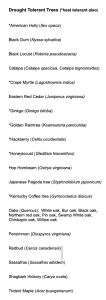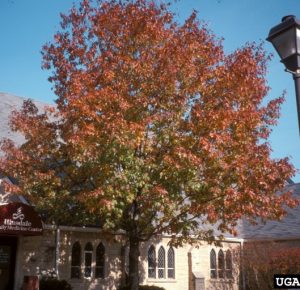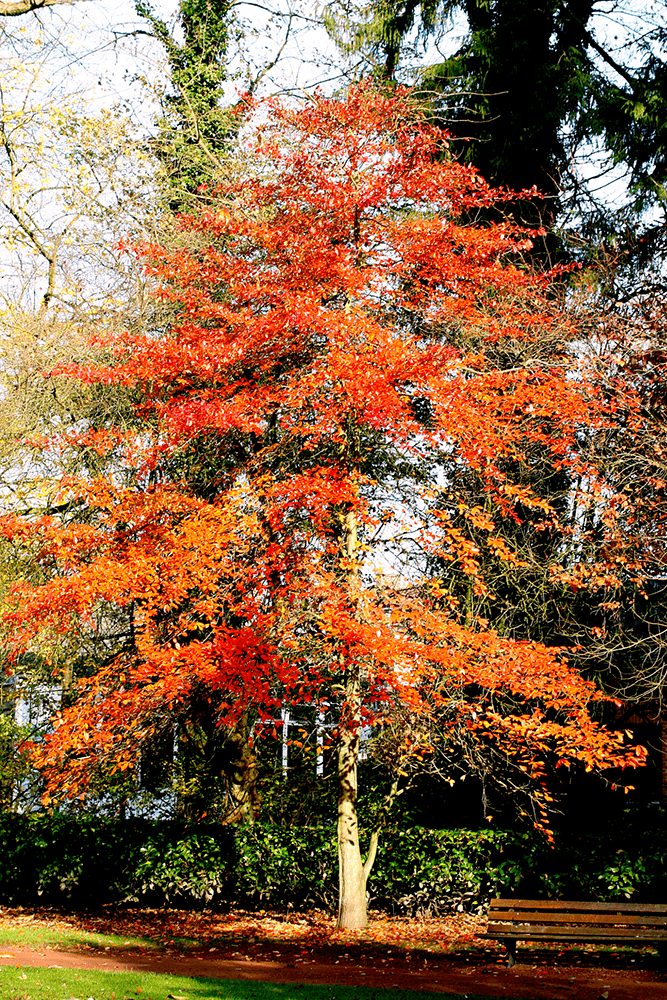 The original idea for this article was to update my 2021 article, “Trees That Can Handle Heat and Drought.” Perhaps my list of heat and drought tolerant trees would need alteration in light of new research. But just as occurred as I worked on that earlier article, the original idea has had to give way due to the results of my recent research. Frankly, I was disappointed; very few new articles address these issues. I suspect that studies are ongoing but that the interlude between the research and publication is longer than I anticipated. In any event, there have been a few developments to report on.
The original idea for this article was to update my 2021 article, “Trees That Can Handle Heat and Drought.” Perhaps my list of heat and drought tolerant trees would need alteration in light of new research. But just as occurred as I worked on that earlier article, the original idea has had to give way due to the results of my recent research. Frankly, I was disappointed; very few new articles address these issues. I suspect that studies are ongoing but that the interlude between the research and publication is longer than I anticipated. In any event, there have been a few developments to report on.
First, I should note that my list of drought and heat tolerant trees is still pretty solid; in fact, many on the list have been confirmed by recent research (the 2021 list is on the right; note that all listed trees were deemed drought tolerant, while those that were considered heat tolerant also are marked with an asterisk). Second, scientists seem to be discovering new and varied ways of assessing heat tolerance, a characteristic that is now considered critical by all concerned. In fact, heat tolerance has been the focus of most of the recent articles unearthed by my research. In view of the recent hot spells we’ve experienced, this focus makes perfect sense.
A recent study conducted in Eastern Tennessee focused solely on heat tolerance, which the scientists measured via leaf temperature as opposed to air temperature. The multi-year study involved 11 species of deciduous trees:
Acer saccharum (Sugar maple)
Celtis laevigata (Sugarberry, a relative of the common hackberry)
Fagus grandifolia (American beech)
Juglans nigra (Black walnut)
Liquidambar styraciflua (American sweetgum)
Liriodendron tulipifera (Tulip poplar)
Ostrya virginiana (American hophornbeam)
Prunus serotina (Black cherry)
Quercus falcata (Southern red oak)
Quercus montana (Chestnut oak)
Ulmus rubra (Slippery elm)
The scientists — from Austin Peay State University — summarized their results as follows:
“In this study, we established the heat tolerances and thermal safety margins for 11 species of hardwood trees common to eastern North America. . . Collectively, our results indicate that stress from high temperatures is common across the forest community and that increasing temperatures from climate change will likely increase the number of species that are heat stressed.
* * *
“Our data show that O. virginiana and U. rubra are routinely heat stressed in current conditions (i.e. largely negative thermal safety margins) that could lead to higher stress under future climate models relative to other species. . . .. In comparison, other species such as J. nigra [black walnut] and C. laevigata [sugarberry] maintain higher heat tolerances and may not face the same levels of stress as other species. However, additional work is needed to understand how additional factors like water stress, leaf traits, and acclimation to elevated temperatures lead to differential responses to heat tolerance and adjustments to leaf temperature in temperate trees.
— ”Leaf temperatures exceed thermal heat tolerances for a community of eastern North America hardwood trees,” Oxford University Press (AoB Plants, 2024)
One important finding of this Tennessee study was that, in all the sampling periods, four species had heat tolerances lower than their leaf temperatures:
- L. tulipifera (tulip poplar),
- Q. falcata (southern red oak),
- Q. montana (chestnut oak), and
- U. rubra (slippery elm).
It saddened me to see the tulip poplar on this list of vulnerable trees as it’s a great favorite of mine. I have to admit, though, that my own tulip poplars have indeed showed signs of heat stress. Experts are warning that we’ll have to adjust to changes in our palette of plantable, resilient trees. I’m struggling with that myself.
Another disappointing fact was reported in a newly-published study suggesting that Norway maple (considered invasive in much of the USA) rates high for heat tolerance. It probably should not be surprising that invasive plants are heat tolerant. The study also identified two trees as more susceptible to heat stress: Bur oak (North American native) and littleleaf linden (a European native). Sigh. To read more about this research, see “Changes in morphological and physiological traits of urban trees in response to elevated temperatures within an Urban Heat Island,” Tree Physiology, (Vol. 44, Issue 12, 2024).

A recent German study confirmed one entry on my 2021 list; it identified Quercus rubra (Northern red oak, a North American native) as having high heat tolerance, though a lesser level of drought tolerance. “Heat tolerance of temperate tree species from Central Europe,” Forest Ecology and Management (Vol. 580, March 2025).
Michigan State University’s Department of Horticulture has been studying heat tolerance by growing trees in greenhouses to simulate increased temperatures. Some species apparently acclimated to the higher temperatures, including swamp white oak (Quercus bicolor), red maple (Acer rubrum), and honeylocust (Gleditsia triacanthos). To learn more about this research, see a webinar titled Urban Tree Selection in a Changing Climate.
I was gratified to see that the Cooperative Extension of Penn. State was giving careful attention to the problem of identifying climate-resilient trees for us to plant. In an article entitled ”Selecting Community Trees in a Changing Climate,” the authors noted that “species like eastern white pine, black cherry, hemlock, and American beech will likely experience severe declines, while blackgum, hackberry, honeylocust, zelkova, oaks, and red maple will adapt better to future climatic conditions in southeastern Pennsylvania. More resources on the USDA Forest Service’s research can be found on the Climate Change Response Framework website.”
I was glad to learn that the Forest Service had something called a Climate Change Response Framework. The site contains recommendations for multiple large cities; the two nearest our region are Washington, DC and Philadelphia. CLIMATE CHANGE VULNERABILITY OF URBAN TREES WASHINGTON, D.C. identifies the following trees as having a low vulnerability to long range climate changes in D.C.:
American sweetgum (fruitless)

Goldenrain tree
Black gum (black tupelo)
Common hackberry
Crapemyrtle
Downy serviceberry
Eastern redcedar
Scarlet oak
Shumard oak
Sourwood
Southern liveoak
Southern magnolia
Trident maple

This list contains many of the trees identified as drought and heat tolerant in my old article. You’ll want to look at the lists of trees at Philadelphia Region: Urban Forest Impacts and Vulnerabilities— which identifies hackberry (Celtis occidentalis), black gum (Nyssa sylvatica) and American holly (Ilex opaca), among others, as highly adaptable to future climate stresses. No surprises there.
I was intrigued by the Forest Service’s new “Assisted Migration” program. Yes, it’s about helping trees migrate to areas where they will be better suited climate-wise than they were in their prior locations. Read more about it here: Seeds of change: Assisted migration and the future of forests (Northern Research Station US Forest Service 2025). Another strategy under study is growing young trees in southern locations and then planting them in northern regions; apparently the trees from the deep South have shown more heat tolerance than those started in northern areas. See TREE CARE INDUSTRY MAGAZINE (2023) for more about this.
Looking at this topic again made it clear that we all need to take even better care of our trees. For helpful guidance on why and how to manage watering during hot droughts, I recommend “Drought and Extreme Heat: Plant Responses and Landscape Maintenance Practices” ( Univ. Of Arizona Coop. Ext. April 2021)
SOURCES:
Featured Photo: Common Hackberry (Celtis occidentalis) by Vern Wilkins, University of Indiana, Bugwood.org
“Leaf temperatures exceed thermal heat tolerances for a community of eastern North America hardwood trees,”.Annals of Botany PLANTS, https://doi.org/10.1093/aobpla/plae060, https://academic.oup.com/aobpla/article/17/3/plae060/78632
”Selecting Community Trees in a Changing Climate,” Penn State Ext. https://extension.psu.edu/selecting-community-trees-in-a-changing-climate
Heat Stress in Urban Trees (Penn.State Ext. (2024) (excellent list of practices to reduce heat stress)
Trees for Hot Sites (Va. Coop.Ext.)
Va Tech publication Problem-free Trees for Va Landscapes (contains a chart that identifies drought-tolerant trees in the Comments section.)